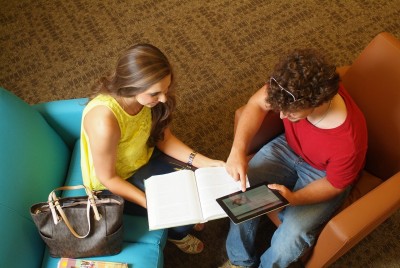By Chelsea Nash, CFICE Communications RA
This is part two of a three-part series on the ABC’s of CCE Partnerships, where we share some of the most important things to keep in mind when engaging in a CCE Partnership. Here, we’ve identified some strategies for sharing resources in a way that empowers the community partner. This article draws from interviews and focus groups conducted in 2015-2016 as part of CFICE’s year 4 project evaluation, and includes common themes from across CFICE’s five Phase I hubs.
A successful community-campus engagement (CCE) partnership requires adequate resources for all participants to be able to do their best work. However, access to resources such as funding, literature, and space typically lies with academic partners and institutions. One CFICE community partner acknowledged this imbalance, speaking to how much community partners rely “on academics with access to resources…We have to hope that they would be amenable to our involvement and inclusion.”
This article outlines three different resources that are important to CCE partnerships: funding, knowledge, and space. Using the results from CFICE’s year 4 project reports, we explore different challenges with, and approaches to, sharing these resources.
Sharing access to financial resources
 CFICE’s year 4 evaluation reports found that, in general, community partners are wary of the external control that institutional funders might exercise over a given project. When funding is coming from academic institutions within a CCE partnership, this power dynamic must be acknowledged and mindfully managed.
CFICE’s year 4 evaluation reports found that, in general, community partners are wary of the external control that institutional funders might exercise over a given project. When funding is coming from academic institutions within a CCE partnership, this power dynamic must be acknowledged and mindfully managed.
Even if funding is coming from an academic institution or from a government agency such as SSHRC, academic partners can take steps to ensure that funding is being effectively mobilized to community partners in a variety of ways.
Some CFICE hubs, such as the Community Environmental Sustainability hub in Ottawa, found a need for “greater support and ease of access to funds,” as the administration of funds fell to one faculty member, simultaneously becoming a logistical burden for them as well as creating an unequal balance of power in the partnership. Similarly, within the Poverty Reduction Hub, financial resources were found to be difficult to access by some community partners, because the “academic manages [the] purse.”
Conversely, the Community Food Security Hub found that leaving the community partner to manage how funds were used burdened the community partner with “too much responsibility and not enough resources” to effectively disseminate funding. This hub found a more collaborative approach to sharing funds was more effective.
While some community partners within the Poverty Reduction hub might have found access to financial resources to be a challenge, funding was mobilized through the employment of research assistants (RAs) whose roles were essential to keeping the project focused and on track.
 The Community Environmental Sustainability Hub in Peterborough similarly found CFICE funding enabled them to increase overall capacity through hiring more RAs, expanding on fundraising activities, and increasing faculty and community capacity for knowledge mobilization.
The Community Environmental Sustainability Hub in Peterborough similarly found CFICE funding enabled them to increase overall capacity through hiring more RAs, expanding on fundraising activities, and increasing faculty and community capacity for knowledge mobilization.
The Community Environmental Sustainability Hub in Ottawa identified a need for adequate resources for all those involved in the partnership. They found acknowledging the “significant in-kind volunteer contributions of time, expertise and mentorship” by way of a financial stipend, for instance, was important for maintaining relationships.
Within CFICE’s Community Food Security Hub, community partners identified a need for a more efficient reimbursement process for expenses incurred by the community partner. The lengthy process for reimbursement was identified as a “bureaucratic barrier”, which particularly impacted those frontline organizations that “cannot carry the overhead of those expenses for long periods of time.”
When managing shared funds, a collaborative approach that includes both community and academic input can mitigate the perception that the academic partner has unilateral control over the funds. As well, prioritizing and being transparent about expense reimbursement processes and timelines can help manage expectations. Finally, increasing community capacity through embedded RAships and by collaboratively budgeting for honouraria or stipends for community work, can contribute to balancing financial power in CCE partnership work.
Ways to share knowledge
 Liz Weaver*, a community partner with Tamarack in the Poverty Reduction Hub, said that “when communities are trying to work and shift more complex issues like poverty, homelessness, the environment, etc., they require the shared wisdom of a wide-variety of diverse partners.” As she suggests through this observation, shared knowledge gives CCE partners power for change. Cultivating this knowledge base is important in achieving results in CCE partnerships.
Liz Weaver*, a community partner with Tamarack in the Poverty Reduction Hub, said that “when communities are trying to work and shift more complex issues like poverty, homelessness, the environment, etc., they require the shared wisdom of a wide-variety of diverse partners.” As she suggests through this observation, shared knowledge gives CCE partners power for change. Cultivating this knowledge base is important in achieving results in CCE partnerships.
Sharing knowledge effectively depends in part on the development of a shared language between community and academic partners.
Within the Community Environmental Sustainability Hub in Peterborough, developing a shared language was discussed frequently. The use of academic language was found to be a barrier that often resulted in “the culture of academia substantively driv[ing] or unduly influenc[ing]” the nature of the project. Academic partners in this context found a need for a “slow encouragement of a more common language” amongst partners, which helped shift power and control over project direction to community partners.
Of course, the necessity of a shared language is context-specific, as different community partners have differing levels of academic experience and vice versa. However, this example points to a need for partners to be aware of how jargon, academic or community-generated, can be an impediment to sharing knowledge.
Another knowledge resource that academic partners might take for granted in CCE partnerships is their unlimited access to library resources.
For instance, the Violence Against Women Hub found that full access to library resources, in particular the online resources, was desired by community partners, though effecting this access proved to be difficult. Having such access can be a significant benefit to community partners, as it can help facilitate fulsome contributions to the research at hand. One community partner saw a lack of access to library resources as a barrier erected by the university “in saying who can and cannot have access to knowledge.”
Taking the time to negotiate access to library resources for community partners during either the grant application stage or initial project meetings is a good way of showing commitment to a community-first ethos in CCE partnerships.While it might take extra time and work, academic partners can also benefit community partners by sharing their personal knowledge and skills. As one community partner said, “When the academic is really willing to put in the work, we get enormous benefits. I’ve learned a lot…but it takes real concession on the part of the academic. It takes extra effort on their part.”
Sharing personal knowledge and skills can mean sharing research knowledge and data, helping partners understand the inner-workings of the institution, or connecting community partners to key resources (people and papers!). Conversely, the academic partner can add benefit to CCE projects by committing to listening and learning from their community partners as well.
Sharing access to space
Access to something like library resources can also be synonymous with access to space. Academic institutions generally have much more (free or cheap) space available for things like meetings and events, which means that CCE meetings often get organized on university campuses.
 This was true in the CFICE project as well. The Poverty Reduction Hub and the Violence Against Women Hub both identified face-to-face meetings to be crucial to the success of the project. One partner within the Violence Against Women Hub said that in-person meetings provided a space for “great information sharing” as well as a venue where concerns could be voiced that might not have come to light otherwise.
This was true in the CFICE project as well. The Poverty Reduction Hub and the Violence Against Women Hub both identified face-to-face meetings to be crucial to the success of the project. One partner within the Violence Against Women Hub said that in-person meetings provided a space for “great information sharing” as well as a venue where concerns could be voiced that might not have come to light otherwise.
However, as found within the Poverty Reduction hub’s report, something as simple as campus parking costs and availability had the potential to create a “huge power imbalance” for community partners.
Conversely, “in-kind donations ([such as] meeting space, meals for focus group participants) greatly facilitated the work of the project,” said one community partner of the ways in which hosting on-campus events helped increase community capacity.
Balancing power and enhancing community capacity
Overall, the ongoing challenge in sharing resources is how access to resources—including funding, knowledge, and space—is managed by academic institutions. Within the context of large academic institutions, community partners are wary of academic knowledge being seen as ‘above’ community knowledge, and how this dynamic is reflected in things like funding decisions, access to space and other resources, like libraries.
As Leighann Burns*, a community partner in the Violence Against Women Hub, emphasized, participating in CCE projects “provid[es] resources and possibilities for those of us on the front lines to implement things we would like to do but don’t have the resources to do.”
By mobilizing funding, allowing access to institutional knowledge sources such as libraries, and being mindful of sharing space in a way that is convenient and accessible to all partners, academic partners can help balance power in CCE partnerships and enhance community capacity.
The attributed quotes used in this article came from CFICE’s Midterm Review Report, which was posted publicly to our website in February, 2016.
